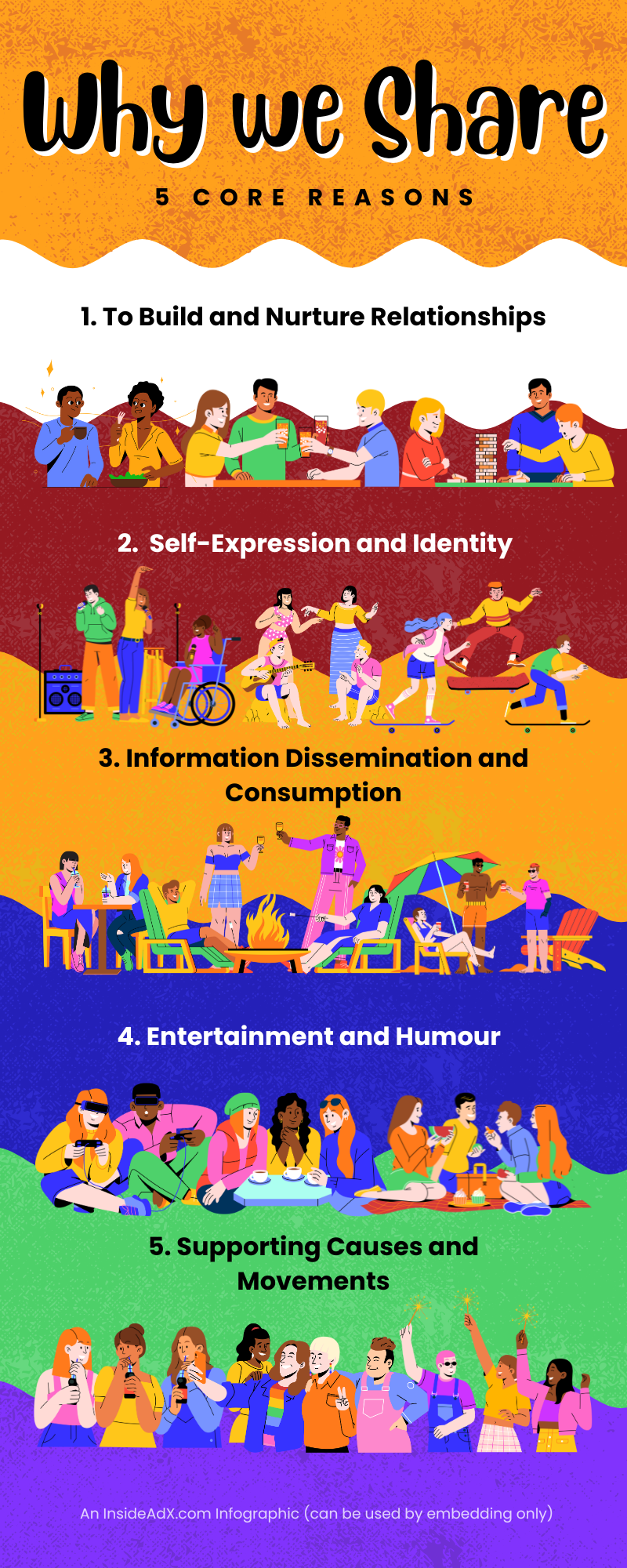Welcome to the digital age, where ‘sharing’ extends beyond a simple social courtesy—it’s become a pivotal aspect of our online lives.
Have you ever paused to ponder why do we share incessantly on social media?
Let’s unravel the psychology behind this phenomenon and uncover some actionable insights to help you get a better grasp over your audiences the next time you run a marketing campaign.
The Historical Context of Sharing
Sharing is an innate human behaviour, historically revolving around physical interactions and resources. However, with the advent of technological advancements, our sharing habits have undergone a significant transformation.
This journey from sharing tangible items around a communal fire to posting status updates in the digital ether is nothing short of revolutionary.
The digital landscape has expanded our reach, enabling us to share not just with those in our immediate vicinity but with a global audience.
– The Evolution of Sharing
From the early days of human civilisation, sharing has been a cornerstone of social cohesion. Our ancestors shared tools, stories, and skills essential for survival. Fast forward to the 21st century, the emergence of the internet, and later social media platforms, revolutionised this concept. Suddenly, sharing expanded from physical items and experiences to digital content – photos, videos, opinions, and life updates.
– The Shift to Digital Spaces
This transition to digital sharing was fueled by the development of social media platforms. Platforms like Facebook, Twitter, and Instagram have created spaces where sharing is instantaneous and boundless. The digitisation of sharing has not only changed what we share but also the speed and scale at which we share.
Why Do We Share: The Five Core Reasons

While the platforms have evolved, the core motivations for sharing remain deeply rooted in human psychology. Here’s a breakdown of the modern motivations for sharing on social media:
1. Building and Nurturing Relationships
At its core, social media sharing is about connection. We share to stay connected with friends and family, to nurture relationships, and to feel a sense of belonging. Sharing life updates, personal achievements, or even everyday moments, helps maintain and strengthen our social bonds.
2. Self-Expression and Identity
Social media offers a platform for self-expression, allowing us to craft and showcase our identities. Sharing opinions, interests, and experiences enables us to define and project our unique selves to the world.
3. Information Dissemination and Consumption
We share to inform and be informed. Whether it’s breaking news, educational content, or lifestyle tips, sharing information is a key aspect of social media interaction.
4. Entertainment and Humour
A significant portion of what is shared online is aimed at entertainment. Funny videos, memes, and lighthearted posts contribute to a culture of sharing that is centered around bringing joy and laughter.
5. Supporting Causes and Movements
Social media has become a powerful tool for advocacy and supporting causes. Sharing content related to social, environmental, or political issues can raise awareness and drive collective action.
Emotional Triggers: The Heart of Sharing

Underlying every share on social media is an emotional trigger. Emotions, both positive and negative, significantly influence our propensity to share. Content that evokes strong emotional responses, be it happiness, anger, or awe, is more likely to be shared.
Recent studies support this: content that triggers high-arousal emotions (like excitement or amusement) or positive feelings (like joy or inspiration) tends to have higher shareability. Conversely, content that evokes sadness can also be widely shared, often driven by empathy and the desire to connect on a deeper emotional level.
The Role of Emotional Content
Emotional content resonates because it feels personal and relatable. A heartwarming story, an inspiring quote, or even a relatable meme can tap into our emotional core, prompting us to share it with our network.
The Viral Equation: Why Do We Share Certain Content More Than Others?
Not all content is created equal in the eyes of shareability. Viral content, the holy grail of social media, possesses certain characteristics that make it more likely to be shared.
Characteristics of Viral Content
- Relatability: Content that audiences can see themselves in tends to be shared more.
- Novelty: Unique, surprising, or new content captures attention and sparks sharing.
- Emotional Impact: As discussed, content that strongly evokes emotions tends to go viral.
- Practical Value: Content that people find useful or informative is often shared.
InsideAdX Spotlight: Do you want content that makes your marketing campaigns successful?
Practical Tips: Crafting Share-Worthy Content
Understanding why we share is one thing, but how do we leverage this knowledge to create content that resonates and encourages sharing?

Here are some practical strategies to help you craft content that taps into the ‘why do we share’ impulse:
1. Know Your Audience
Understanding your audience is critical. Tailor your content to their interests, needs, and preferences. Use analytics and feedback to continually refine your understanding of what resonates with them.
2. Tell a Story
Storytelling is a powerful tool in content creation. A compelling narrative can engage your audience emotionally, making your content more memorable and shareable. Whether it’s a customer success story, a behind-the-scenes look at your business, or a personal anecdote, stories can create a deeper connection with your audience.
3. Create Visually Appealing Content
In a world where attention spans are short, visually striking content can make your message stand out. Use high-quality images, engaging graphics, and eye-catching layouts to draw attention and encourage sharing.
4. Leverage Trends and Timeliness
Content that ties into current trends or events can ride the wave of public interest. However, it’s crucial to stay relevant to your brand and audience while doing so. Utilizing trending hashtags, participating in popular challenges, or commenting on current events can increase your content’s visibility and shareability.
5. Encourage Interaction
Create content that invites interaction, such as polls, quizzes, or questions. Interactive content not only engages your audience but also increases the likelihood of shares as people like to share their opinions and see what others think.
6. Offer Value
Whether it’s educational, inspirational, or entertaining, ensure your content offers value to your audience. People are more likely to share content that they find useful or that they think will benefit others.
7. Use Humour Wisely
Humour can be a powerful tool for engagement, but it must be used wisely and appropriately. Understand your audience well enough to know what type of humour will resonate without offending.
8. Include Calls-to-Action
Sometimes, all it takes to encourage sharing is a simple call-to-action. Phrases like “Share this with a friend who would love this!” can be surprisingly effective.
Conclusion: Why Do We Share & How You can Create Successful Campaigns
In understanding the nuances of why we share on social media, we unlock the potential to create more impactful, engaging content.
By tapping into the psychological underpinnings and emotional triggers of sharing, and utilising practical tips for crafting share-worthy content, we can enhance our social media engagement significantly.
As we continue to navigate the ever-evolving landscape of digital communication, keeping these insights in mind will not only help us connect more deeply with our audiences but also empower us to use the power of sharing to its fullest potential.
So, as you go forth and create, remember the power behind each share and the opportunity it presents to connect, engage, and inspire.
Source:
– A Jonah Berger Study

